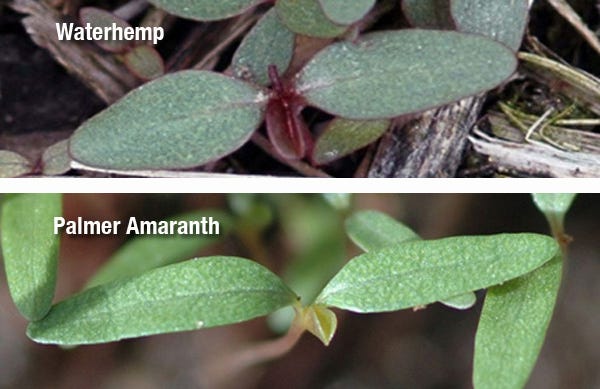June 7, 2013

Palmer amaranth (Amaranthus palmeri) is a summer annual broadleaf weed species taxonomically related to other pigweed species (waterhemp, smooth, redroot) common in Illinois agronomic cropping systems. Palmer amaranth is not indigenous to Illinois, but rather evolved as a desert-dwelling species in the southwestern United States including areas of the Sonoran Desert. Genotypic and phenotypic adaptability have allowed Palmer amaranth to expand its distribution and colonize the vastly different agricultural landscapes across much of the eastern half of the United States, including Illinois.
Research has demonstrated that Palmer amaranth has a higher growth rate and is more competitive than other pigweed species. Growth rates approaching 3 in./day and yield losses of 78% (soybean) and 91% (corn) attributed to Palmer amaranth interference have been reported in the scientific literature. Seed production capability of female Palmer amaranth plants is similar to that of female waterhemp plants.
Early and accurate identification of Palmer amaranth plants coupled with implementation of an integrated management program are essential to reduce the potential for crop yield loss due to interference of Palmer amaranth. Proper management of Palmer amaranth populations can help reduce the potential for successful seed production that will augment the soil seedbank and perpetuate the population in future growing seasons.
Like what you're reading? Subscribe to CSD Extra and get the latest news right to your inbox!
To assist weed management practitioners in accurately identifying Palmer amaranth, you may send us tissue samples from suspected Palmer amaranth plants and we will use tools of molecular biology to identify whether the sample is Palmer amaranth or another species of Amaranthus. Information on how to collect and submit tissue samples from suspected Palmer amaranth plants can be found in the Palmer Amaranth Identification form (pdf). Please download this form, provide as much information as possible, and submit it along with the tissue samples to the address listed at the top of the form.
Read the article at The Bulletin.
 You might also like:
You might also like:
Soil Residual Herbicide Options After Soybean, Corn Emergence
You May Also Like




